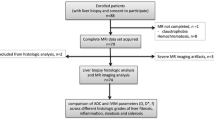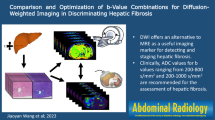Abstract
Objectives
To investigate the reliability of diffusion-weighted magnetic resonance imaging (DW-MRI) for staging liver fibrosis in the presence of fat and iron.
Methods
Ninety-five patients, including 48 men and 47 women, aged 57.0 ± 14.2 years, underwent liver biopsy. Ninety-six samples were histologically staged for liver fibrosis (0-Ishak score 0; 1-Ishak score 1–4; 2-Ishak score 5–6) and semiquantitatively graded for hepatic iron (0, no; 1, low; 2, moderate; 3, high iron) and for hepatic steatosis. Within 72 h after biopsy, navigator-triggered DW-MRI using b-values of 50/400/800 s/mm2 was performed in a 1.5-T system, and apparent diffusion coefficients (ADC) were analysed. ADCs were correlated with fibrosis stage, steatosis grade, and iron grade using linear regression.
Results
ADC did not correlate with fibrosis stages in either the overall group (n = 96; R 2 = 0.38; P = 0.17) or in the subgroup without liver iron and steatosis (n = 40; R 2 = 0.01; P = 0.75). ADC decreased significantly with steatosis grade in cases without iron and fibrosis (n = 42; R 2 = 0.28; ß = -5.3; P < 0.001). Liver iron was modestly correlated with ADC in patients without fibrosis and steatosis (n = 33; R 2 = 0.29; P = 0.04), whereas high iron concentrations were associated with low ADC values (group 3: β = -489; P = 0.005; reference:group 0) but intermediate levels were not (group 1/group 2: P = 0.93/P = 0.54; reference group: 0).
Conclusions
ADC values are confounded by fat and iron. However, even in patients without fat or iron, DW-MRI does not adequately discriminate the stage of fibrosis.
Key Points
• Diffusion-weighted magnetic resonance imaging (DW-MRI) is increasingly used to evaluate liver disease.
• DWI using b-values of 50/400/800 s/mm 2 does not adequately quantify fibrosis.
• Assessment of the apparent diffusion coefficient (ADC) is confounded by fat and iron.
• Fat may influence ADCs by altering water diffusion.
• Iron may influence ADCs by signal decay and noise floor effects.



Similar content being viewed by others
References
Colombo M, de Franchis R, Del Ninno E, Sangiovanni A, De Fazio C, Tommasini M, Donato MF, Piva A, Di Carlo V et al (1991) Hepatocellular carcinoma in Italian patients with cirrhosis. N Engl J Med 325:675–680
Thampanitchawong P, Piratvisuth T (1999) Liver biopsy: complications and risk factors. World J Gastroenterol 5:301–304
Perrault J, McGill DB, Ott BJ, Taylor WF (1978) Liver biopsy: complications in 1000 inpatients and outpatients. Gastroenterology 74:103–106
Ratziu V, Charlotte F, Heurtier A, Gombert S, Giral P, Bruckert E, Grimaldi A, Capron F, Poynard T et al (2005) Sampling variability of liver biopsy in nonalcoholic fatty liver disease. Gastroenterology 128:1898–1906
Ratziu V, Bugianesi E, Dixon J, Fassio E, Ekstedt M, Charlotte F, Kechagias S, Poynard T, Olsson R (2007) Histological progression of non-alcoholic fatty liver disease: a critical reassessment based on liver sampling variability. Aliment Pharmacol Ther 26:821–830
Ong TZ, Tan HJ (2003) Ultrasonography is not reliable in diagnosing liver cirrhosis in clinical practice. Singap Med J 44:293–295
Di Lelio A, Cestari C, Lomazzi A, Beretta L (1989) Cirrhosis: diagnosis with sonographic study of the liver surface. Radiology 172:389–392
Brancatelli G, Federle MP, Ambrosini R, Lagalla R, Carriero A, Midiri M, Vilgrain V (2007) Cirrhosis: CT and MR imaging evaluation. Eur J Radiol 61:57–69
Godfrey EM, Patterson AJ, Priest AN, Davies SE, Joubert I, Krishnan AS, Griffin N, Shaw AS, Alexander GJ et al (2012) A comparison of MR elastography and (31)P MR spectroscopy with histological staging of liver fibrosis. Eur Radiol. doi:10.1007/s00330-012-2527-x
Kim KA, Park M-S, Kim I-S, Kiefer B, Chung W-S, Kim M-J, Kim KW (2012) Quantitative evaluation of liver cirrhosis using T1 relaxation time with 3 Tesla MRI before and after oxygen inhalation. J Magn Reson Imaging. doi:10.1002/jmri.23620
Bonekamp S, Torbenson MS, Kamel IR (2011) Diffusion-weighted magnetic resonance imaging for the staging of liver fibrosis. J Clin Gastroenterol 45:885–892
Bakan AA, Inci E, Bakan S, Gokturk S, Cimilli T (2011) Utility of diffusion-weighted imaging in the evaluation of liver fibrosis. Eur Radiol 22:682–687
Yin M, Talwalkar JA, Glaser KJ, Manduca A, Grimm RC, Rossman PJ, Fidler JL, Ehman RL (2007) Assessment of hepatic fibrosis with magnetic resonance elastography. Clin Gastroenterol Hepatol 5:1207–1213.e2
Huwart L, Peeters F, Sinkus R, Annet L, Salameh N, ter Beek LC, Horsmans Y, Van Beers BE (2006) Liver fibrosis: non-invasive assessment with MR elastography. NMR Biomed 19:173–179
Hu X-F, Liu B, Qian Y-F, Zhang C, Yu Y-Q (2008) A pilot study of hepatic fibrosis with magnetic resonance diffusion-weighted imaging in a rabbit model. Zhonghua Gan Zang Bing Za Zhi 16:500–504
Zhu N-Y, Chen K-M, Chai W-M, Li W-X, Du L-J (2008) Feasibility of diagnosing and staging liver fibrosis with diffusion weighted imaging. Chin Med Sci J 23:183–186
Sandrasegaran K, Akisik FM, Lin C, Tahir B, Rajan J, Saxena R, Aisen AM (2009) Value of diffusion-weighted MRI for assessing liver fibrosis and cirrhosis. Am J Roentgenol 193:1556–1560. doi:10.2214/AJR.09.2436
Annet L, Peeters F, Abarca-Quinones J, Leclercq I, Moulin P, Van Beers BE (2007) Assessment of diffusion-weighted MR imaging in liver fibrosis. J Magn Reson Imaging 25:122–128
Bruegel M, Holzapfel K, Gaa J, Woertler K, Waldt S, Kiefer B, Stemmer A, Ganter C, Rummeny EJ (2008) Characterization of focal liver lesions by ADC measurements using a respiratory triggered diffusion-weighted single-shot echo-planar MR imaging technique. Eur Radiol 18:477–485
Namimoto T, Yamashita Y, Sumi S, Tang Y, Takahashi M (1997) Focal liver masses: characterization with diffusion-weighted echo-planar MR imaging. Radiology 204:739–744
Taouli B, Martin AJ, Qayyum A, Merriman RB, Vigneron D, Yeh BM, Coakley FV (2004) Parallel imaging and diffusion tensor imaging for diffusion-weighted MRI of the liver: preliminary experience in healthy volunteers. AJR Am J Roentgenol 183:677–680
Do RKG, Chandarana H, Chandanara H, Felker E, Hajdu CH, Babb JS, Kim D, Taouli B (2010) Diagnosis of liver fibrosis and cirrhosis with diffusion-weighted imaging: value of normalized apparent diffusion coefficient using the spleen as reference organ. Am J Roentgenol 195:671–676
Poyraz AK, Onur MR, Kocakoç E, Oğur E (2011) Diffusion-weighted MRI of fatty liver. J Magn Reson Imaging. doi:10.1002/jmri.23519
Lee JT, Liau J, Murphy P, Schroeder ME, Sirlin CB, Bydder M (2012) Cross-sectional investigation of correlation between hepatic steatosis and IVIM perfusion on MR imaging. Magn Reson Imaging 30:572–578
St Pierre TG, Clark PR, Chua-anusorn W, Fleming AJ, Jeffrey GP, Olynyk JK, Pootrakul P, Robins E, Lindeman R (2005) Noninvasive measurement and imaging of liver iron concentrations using proton magnetic resonance. Blood 105:855–861
Ishak K, Baptista A, Bianchi L, Callea F, De Groote J, Gudat F, Denk H, Desmet V, Korb G et al (1995) Histological grading and staging of chronic hepatitis. J Hepatol 22:696–699
Kühn JP, Evert M, Friedrich N, Kannengiesser S, Mayerle J, Thiel R, Lerch MM, Dombrowski F, Mensel B et al (2011) Noninvasive quantification of hepatic fat content using three-echo Dixon magnetic resonance imaging with correction for T2* relaxation effects. Invest Radiol 46:783–789
Soylu A, Kiliçkesmez O, Poturoğlu S, Dolapçioğlu C, Serez K, Sevindir I, Yaşar N, Akyildiz M, Kumbasar B (2010) Utility of diffusion-weighted MRI for assessing liver fibrosis in patients with chronic active hepatitis. Diagn Interv Radiol 16:204–208
Le Bihan D (1995) Molecular diffusion, tissue microdynamics and microstructure. NMR Biomed 8:375–386
Le Bihan D, Turner R, Douek P, Patronas N (1992) Diffusion MR imaging: clinical applications. AJR Am J Roentgenol 159:591–599
Kim YK, Lee MW, Lee WJ, Kim SH, Rhim H, Lim JH, Choi D, Kim Y-S, Jang KM et al (2012) Diagnostic accuracy and sensitivity of diffusion-weighted and of gadoxetic acid-enhanced 3-T MR imaging alone or in combination in the detection of small liver metastasis (≤ 1.5 cm in diameter). Invest Radiol 47:159–166
Kenis C, Deckers F, De Foer B, Van Mieghem F, Van Laere S, Pouillon M (2012) Diagnosis of liver metastases: can diffusion-weighted imaging (DWI) be used as a stand alone sequence? Eur J Radiol 81:1016–1023
Yuan Z, Ye X-D, Dong S, Xu L-C, Xu X-Y, Liu S-Y, Xiao X-S (2010) Role of magnetic resonance diffusion-weighted imaging in evaluating response after chemoembolization of hepatocellular carcinoma. Eur J Radiol 75:e9–e14
Ichikawa S, Motosugi U, Ichikawa T, Morisaka H, Sano K, Wakayama T, Araki T (2012) Intravoxel incoherent motion imaging of the liver: Which affects more on apparent diffusion coefficient changes of cirrhosis and liver lesions, D or D*? ISMRM, 20th ed. Melbourne
Hernando D, Karampinos DC, King KF, Haldar JP, Majumdar S, Georgiadis JG, Liang Z-P (2011) Removal of olefinic fat chemical shift artifact in diffusion MRI. Magn Reson Med 65:692–701
Tonan T, Fujimoto K, Qayyum A, Kawaguchi T, Kawaguchi A, Nakashima O, Okuda K, Hayabuchi N, Sata M (2012) Quantification of hepatic iron concentration in chronic viral hepatitis: usefulness of T2-weighted single-shot spin-echo echo-planar MR imaging. PLoS One 7:e33868
Qayyum A (2009) Diffusion-weighted imaging in the abdomen and pelvis: concepts and applications. Radiographics 29:1797–1810
Naganawa S, Sato C, Nakamura T, Kumada H, Ishigaki T, Miura S, Maruyama K, Takizawa O (2005) Diffusion-weighted images of the liver: comparison of tumor detection before and after contrast enhancement with superparamagnetic iron oxide. J Magn Reson Imaging 21:836–840
Acknowledgments
Robin Bülow and Jens-Peter Kühn contributed equally to this work.
Some of subjects were prospectively enrolled in another study: “Kühn JP, Evert M, Friedrich N, et al. (2011) Noninvasive quantification of hepatic fat content using three-echo dixon magnetic resonance imaging with correction for T2* relaxation effects. Invest Radiol 46:783-9. PubMed PMID: 21808200”. In this prospective study, we investigated a chemical shift-encoded MRI for liver fat quantification compared to histology. In the present study, retrospective data evaluation was performed to assess liver fibrosis using diffusion-weighted MR imaging.
Author information
Authors and Affiliations
Corresponding author
Rights and permissions
About this article
Cite this article
Bülow, R., Mensel, B., Meffert, P. et al. Diffusion-weighted magnetic resonance imaging for staging liver fibrosis is less reliable in the presence of fat and iron. Eur Radiol 23, 1281–1287 (2013). https://doi.org/10.1007/s00330-012-2700-2
Received:
Revised:
Accepted:
Published:
Issue Date:
DOI: https://doi.org/10.1007/s00330-012-2700-2




